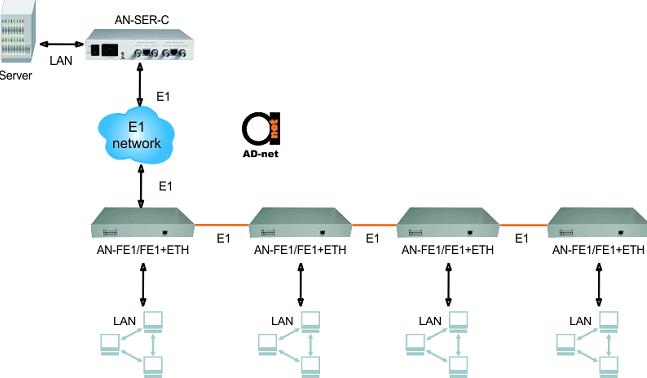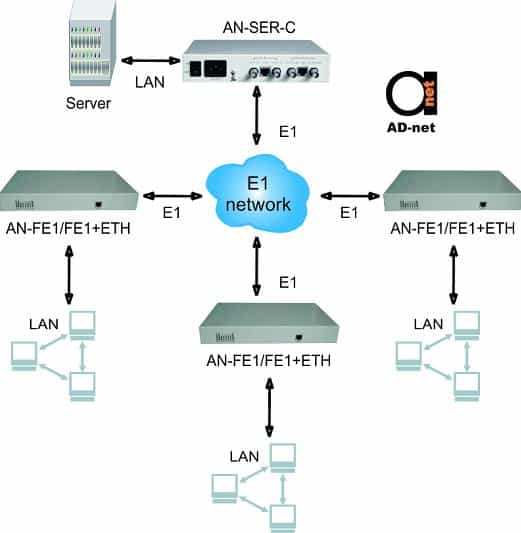2 E1 Add/Drop type to 10/100 BaseT Ethernet converter
2 x framed E1 port - Sub E1 and Main E1 to 10/100BaseT converter - access solution. Converter can drop several continuous timeslots from the up standard ITU-T G.703 E1 interface as Ethernet service, and the remainder is straight-through from up E1 to down E1.
- The integrated circuit is based on our own intellectual property rights.
- G.703 E1 line adopts HDB3 encoding, and the E1 interface channel and coding mode are in line with the ITU-T G.703 and ITU-T G.704 protocols.
- All-digital clock recovery technology and integrated phase locked loop are adopted and the jitter performance is far superior to G.823 and G.742 protocol standards;
- Rate of the interface: 2.048Mbit/s±50ppm, the data transmission rate supports N*64K (N=1~32), and the hardware realizes arbitrary selection of the several continuous timeslots from 31 timeslots.
- Clock mode: The output clock of up E1 is as dropped clock from input up E1 signal. Line clock in down line (synchronized to down received clock)/main clock (own crystal clock) (optional).
- Full indicators for alarm indication on panel.
- The ETH interface is adaptive for crossover or straight-through cable, and supports 10M / full-duplex 10M / half-duplex, 100M / half-duplex, 100M / full-duplex, 10M/100M adaptive mode.
The network administration channel is reserved; the network administration function can be added according to the need. - 2 E1 framed ports – Sub E1 and Main E1.
- Daisy chain, Star and Point to Point configurations possible;
Sub & Main E1 port interface parameter:
- Channel capacity: 1 Channels
- interface rate: unframing/framing: N*64Kbps,N=0~31;
- Bit Rate: 2.048 Mb/s ±50 ppm
- Line Code: HDB3
- Line Impedance: 120 Ohm / 75 Ohm
- Connector: RJ-45 or BNC
- Pulse Shape: ITU-T G.703.
- Jitter Performance: ITU-T G.823
- clock: inter-clock, line-clock
- Output jitter<0.05UI
Ethernet interface:
- Interface Rate: 10/100Mbps
- Duplex: half and full duplex self-adapt.
- Interface character: match IEEE802.3, IEEE802.1 Q(VLAN)
- Connector: RJ45, support auto-mdix
- MAC address capability: 4096
Power:
- DC: -48V (-36 to -72V);
- AC: 90 to 260 VAC ; 47 ~ 63Hz
- Power Interface: DC power terminal / AC socket
- Power Consumption: <5 W
Working environment:
- Operating temperature: 0 to 50 °C
- Storage temperature: -20; to +70 °C
- Relative humidity: 5% to 90% (25 °C no condense)
Dimensions
Width 230mm × Height 49mm×Depth 143mm
Application Scenarios

Point to point scenario with multiplexing E1 framed sub E1 and Ethernet into 1 main E1 uplink.

Daisy chain with a central convergence server – each node uses 1 time slot.
Star Configuration central convergence server – each node uses 1 time slot.
| AN-FE1/FE1+ETH/AC | 2 x framed E1 Sub E1 & and Main E1 to Ethernet converter. AC 96 - 260- V AC, 75/120 ohm impedance for E1 port. |
|
| AN-FE1/FE1+ETH/DC | 2 x framed E1 Sub E1 & and Main E1 to Ethernet converter. DC 48V, 75/120 ohm impedance for E1 port. |
Description
AN-FE1/FE1+ETH Interface Converter is an economical digital access solution to framed E1 and partial E1 network service. The device can drop several continuous timeslots from the up standard ITU-T G.703 E1 interface as Ethernet service, and the remainder is straight-through from up E1 to down E1. The device can be cascade connected to the same devices or the other related devices, each node uses several timeslot, and the 32 timeslots in E1 make it possible that the data from 31 nodes can be collected to the center node to be transmitted by 2M channel. The device is suitable for the service transmux in one E1 from several nodes with little transmission services and it increases the utilization rate of the E1 resource and reduces the quantity and simplifies the structure of the network. It can be used to connect the down E1 circuit to public E1 network, or connect the down E1 to PABX or other E1 devices through timeslot drop/insert then to public network. The down E1 and ETH are absolutely physically isolated.
Additional information
| E1 ports | 2 |
|---|

